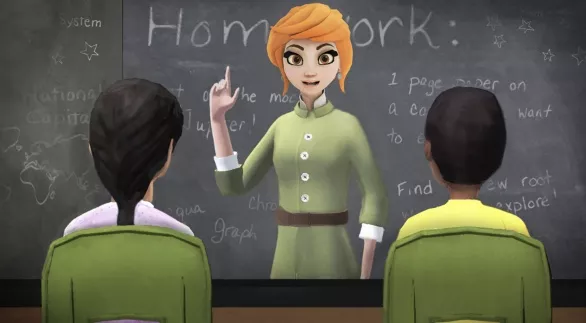Conversations contain a vast array of rapidly changing verbal and nonverbal signals. Participating in conversations requires the ability to adapt fluidly to those changing signals in order to understand and respond to the dialogue. In Floreo's growing catalogue, we have a wide variety of VR experiences that supports both individuals who need to work on specific components of a conversation as well as more free flowing interchanges that allow Learners to respond to, as well as direct their conversations.
At one of our more rudimentary levels, we find that some Learners need practice understanding how to listen for a conversational topic, identify the topic and then offer a relevant comment. Sometimes, the Learner has not understood the topic of the conversation. Other times, the challenge for the Learner is in offering a comment related to the topic. When first using Join a Conversation: Park and Join a Conversation: Cafeteria, the Coach may want to choose a topic of conversation without telling the Learner which topic is being chosen. This way the Coach can evaluate whether there is any breakdown in this skill for this Learner. If there is a breakdown, the lesson can be adapted to determine where the breakdown is.
If the Learner has difficulty chiming in with a relevant comment, the Coach could repeat the lesson, but this time ask the Learner to label the topic before proceeding to the step where the Learner is asked to offer a comment. When Learners have difficulty labeling the topic, it may be helpful to work on keywords in a sentence as well as practice using some activities outside of VR. For additional thoughts on how to introduce this teaching, see this previous blog post on finding the topic.
If the Learner is able to identify the topic, the challenge may be either in thinking of something related to the topic or in formulating an on-topic comment. If this is an area of need, Learners can practice identifying their favorites related to a topic, or identifying a recent event related to the topic. We may need to provide Learners with choices (e.g. "Do you like thin crust pizza or thick crust pizza?") or leading questions ("What was the last movie you saw?") or provide them with a verbal model ("You could say, "I like chocolate chip ice cream.'")
When a Learner has a bit more proficiency understanding the topic of conversation, Floreo has the Intro to Small Talk series, including Intro to Small Talk with May , Intro to Small Talk with Brandon, and Intro to Small Talk with Carlos, where the Learner can practice identifying subtle changes in mood of a conversational partner and learn how to respond accordingly, by saying things like, "That's cool!" or "That's too bad." Then, we have some more dynamic conversations in Chit-Chat with Myra, Chit-Chat with Alejandro, and Chit-Chat with Ayanna. In these lessons, the Learner is able to practice multiple turns of a conversation, practice adjusting to a change in the conversation and reinforce the ability to recognize a change in the mood of the speaker.
One of our most exciting recent developments is the release of our new AI driven conversation lessons: Conversation Corner with Jordan and Marcie: Park and Conversation Corner with Jordan and Marcie: Movie Theater. The AI driving these lessons allows Floreo Learners to ask questions, choose a topic of conversation, and truly engage in a naturalistic exchange of information where the character will respond to what the Learner has said and ask follow up questions in real time. We are very excited to see where these lessons will take our Floreo users.
This outlines only a handful of our conversation lessons, but exemplifies the breadth of content we have been able to create so far. Look for more to come. Let us know if you have Learners who struggle with a particular aspect of conversation that you would like to see in Floreo.
Floreo's Director of Applied Digital Therapy, Rita Solórzano MA, CCC-SLP, is a Speech Language Pathologist with over 30 years of experience.





-1.png?width=550&height=250&name=Untitled%20(3)-1.png)